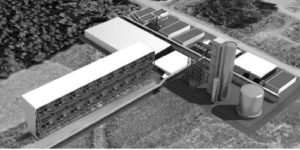By Gagandeep Ghuman
Published: April 11, 2018
A clean tech company is asking for an OCP amendment and rezoning to make way for a commercial carbon capture close to the district landfill.
The company wants the district to remove their proposed site from the OCP’s Debris Flow Hazard Area schedules and the Cheekeye Fan Special Study Area.
Their request is based on a 2015 report prepared by BGC Engineering for the other Cheekeye Fan development application in progress, which indicates that large parts of this site are not impacted by debris flow models.

Carbon Engineering, has submitted an OCP amendment and rezoning application on a 60-acre site located at the corner of Squamish Valley Road southwest of the district landfill in the Cheekeye Fan area, land which was recently acquired by the Squamish Nation from the province.
Carbon Engineering is seeking to establish a carbon capture and a synthetic fuel demonstration and commercial production plant in two phases.
The company will use Air to Fuel technology, a system that ‘directly synthesis transportation fuels–such as gasoline, diesel, or Jet A- from only atmospheric CO2 and hydrogen split from water, and powered by clean electricity”
The Air to Fuel (A2F), proponents say, has intrinsic advantages when it comes to eliminating fossil carbon dioxide emissions from the transportation sector.
Air to fuel can use solar power and produce fuel that is a 100 times less water and lower GHE foot print.
In Phase one of the project, the applicant is proposing to expand the carbon capture operation, currently located on the Squamish Oceanfront, and in phase two, commercial-level production of Air to Fuel would be developed.
Over the two phases, the project would consist of an approximately 4,000 square metre office and lab building while the rest of the air capture and fuel synthesis equipment would be located outdoor on concrete pads.
The total employment capacity at the site is expected to be approximately 100 personnel. The plant could produce approximately two barrels of fuel per day with fuel storage of up to 60 barrels on-site.
There would be up to 10 fuel transport pickups per day once the commercial operation is running. Maximum fuel storage capacity onsite would be established at 60,000 barrels but the applicants are proposing that no more than 28,000 barrels would be stored onsite at a time.
Currently, the OCP designates the subject site as Limited Use and Restricted Industrial. The application, the company says, is consistent with district policies that support green energy and GHE reductions.


Dave Colwell says
Great idea….bring it on!
Glenne Campbell says
Who would pay for the infrastructure that needs to be installed: Water, Electricity, Sewer, Digital?
Murray Sovereign says
Production of two barrels per day, on-site storage of up to 60,000 barrels, and up to ten fuel pickups per day? So each pickup is for 1/5 of a barrel and they have enough storage for 300,000 pickups, or 30,000 days? There’s something missing here. I’m assuming the two barrels per day is for the research lab, and the ten pickups per day plus 60,000 barrels of storage is for the commercial plant, but I can’t tell what the forecasted output of the commercial plant would be.